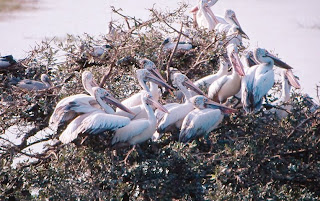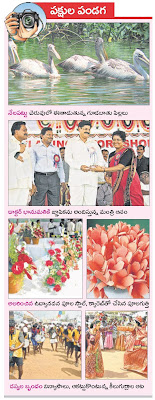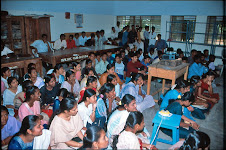PLBLS Started New website with more information about pulicat and Nelapattu Bird Sanctuaries. Please visit www.pulicat.org for photos , videos and latest updates
Tuesday, January 15, 2013
The Hindu : Life & Style / Metroplus : All for winged friends
Hindu Published about 'Birds of pulicat lake'
Birds of Pulicat Lake” is another feather in ecologist P. J. Sanjeeva Raj's cap
Restoration ecologist P.J. Sanjeeva Raj has melded academics with activism. Head of the zoology department at Madras Christian College from the 1960s to the 1980s, he turned the Pulicat lake into a field of experiment.
He has led many initiatives to protect the ecological balance of this lagoon, second largest in the country; his magnum opus is the Estuarine Biological Laboratory built at Pulicat Town in 1969.
Eighty-three-year-old Raj's interest in the region has not waned. Still an authority on the lake, he volunteers information about it. He continues to foster eco-awareness among residents and is the founder of the Pulicat Lake Bird Lovers' Society (PLBLS), a voluntary organisation that aids and provokes research on the bird life.
Local partnership
The Society is not shut up in an intellectual ivory tower, but partners with the locals in protecting Pulicat birds. It organises excursions and functions as a window to Pulicat's rich biodiversity. For its supportive role at the Flamingo Festival (an annual attraction at Sullurpet), PLBLS won the ‘Best Society Award' for four years on the trot (2004 to 2007).
Drawing upon his knowledge gained by a continuous observation of the lake, he has now written Birds Of Pulicat Lake. Meant to be a quick guide to bird-watching in Pulicat, he collaborated with Odd W. Jacobsen, associate professor in animal ecology at Bergen University College, Norway, for the book.
Raj underlines the importance of the neighbouring freshwater Nellapattu Sanctuary in the book. “The Pulicat and Nellapattu sanctuaries complement each other. The Pulicat lake with brackish water serves as a feeding habitat; Nellapattu is breeding ground for these birds.”
Together, these sanctuaries support seven threatened species of birds — spot-billed pelican, painted stork, white ibis, darter, lesser flamingo, marbled teal and black-bellied tern.
For Raj, a peek into the fascinating world of birds can make youngsters sensitive to the issues of global ecology. Birds have scant regard for national boundaries; they bring out the common thread running through Nature.
From China to Venadu
“The bar-headed goose breeds in the lakes of Tibet, Ladakh and China, but leaves high altitudes in the winter months. Flying high over the Himalayas at an altitude of 33,000 feet, in the jet stream, the bird travels towards Pulicat. It can be seen foraging in the paddy fields on Venadu Island in the South and Moolah village in the North.”
Raj says the case of the spot-billed pelican emphasises how even salutary human action can negatively impact Nature.
"At one time, these squat birds were found in millions in south and south-east Asia. Indiscriminate use of DDT, especially in south-east Asia, during the Green Revolution after World War II led to these birds laying thin-shelled eggs. Naturally, their numbers dwindled alarmingly. The subsequent blue revolution (aquaculture on a mass scale) in the region left the bird with no trees to nest and breed. A remnant of the spot-billed pelicans in south-east Asia escaped to Assam and South India. The pelican population in South India is now picking up."
Raj says Pulicat and Nelapattu sanctuaries have contributed immensely to the protection of this pelican. “Located close to a rocket-launching station, these twin sanctuaries have few parallels in the world. They illustrate that, when planned, development can go hand in hand with Nature.” For details about the book, call 26185188.
Birds of Pulicat Lake” is another feather in ecologist P. J. Sanjeeva Raj's cap
Restoration ecologist P.J. Sanjeeva Raj has melded academics with activism. Head of the zoology department at Madras Christian College from the 1960s to the 1980s, he turned the Pulicat lake into a field of experiment.
He has led many initiatives to protect the ecological balance of this lagoon, second largest in the country; his magnum opus is the Estuarine Biological Laboratory built at Pulicat Town in 1969.
Eighty-three-year-old Raj's interest in the region has not waned. Still an authority on the lake, he volunteers information about it. He continues to foster eco-awareness among residents and is the founder of the Pulicat Lake Bird Lovers' Society (PLBLS), a voluntary organisation that aids and provokes research on the bird life.
Local partnership
The Society is not shut up in an intellectual ivory tower, but partners with the locals in protecting Pulicat birds. It organises excursions and functions as a window to Pulicat's rich biodiversity. For its supportive role at the Flamingo Festival (an annual attraction at Sullurpet), PLBLS won the ‘Best Society Award' for four years on the trot (2004 to 2007).
Drawing upon his knowledge gained by a continuous observation of the lake, he has now written Birds Of Pulicat Lake. Meant to be a quick guide to bird-watching in Pulicat, he collaborated with Odd W. Jacobsen, associate professor in animal ecology at Bergen University College, Norway, for the book.
Raj underlines the importance of the neighbouring freshwater Nellapattu Sanctuary in the book. “The Pulicat and Nellapattu sanctuaries complement each other. The Pulicat lake with brackish water serves as a feeding habitat; Nellapattu is breeding ground for these birds.”
Together, these sanctuaries support seven threatened species of birds — spot-billed pelican, painted stork, white ibis, darter, lesser flamingo, marbled teal and black-bellied tern.
For Raj, a peek into the fascinating world of birds can make youngsters sensitive to the issues of global ecology. Birds have scant regard for national boundaries; they bring out the common thread running through Nature.
From China to Venadu
“The bar-headed goose breeds in the lakes of Tibet, Ladakh and China, but leaves high altitudes in the winter months. Flying high over the Himalayas at an altitude of 33,000 feet, in the jet stream, the bird travels towards Pulicat. It can be seen foraging in the paddy fields on Venadu Island in the South and Moolah village in the North.”
Raj says the case of the spot-billed pelican emphasises how even salutary human action can negatively impact Nature.
"At one time, these squat birds were found in millions in south and south-east Asia. Indiscriminate use of DDT, especially in south-east Asia, during the Green Revolution after World War II led to these birds laying thin-shelled eggs. Naturally, their numbers dwindled alarmingly. The subsequent blue revolution (aquaculture on a mass scale) in the region left the bird with no trees to nest and breed. A remnant of the spot-billed pelicans in south-east Asia escaped to Assam and South India. The pelican population in South India is now picking up."
Raj says Pulicat and Nelapattu sanctuaries have contributed immensely to the protection of this pelican. “Located close to a rocket-launching station, these twin sanctuaries have few parallels in the world. They illustrate that, when planned, development can go hand in hand with Nature.” For details about the book, call 26185188.
Monday, March 8, 2010
Flamingo Festival 2010
Thursday, February 18, 2010
Hindu Published about 'Birds of pulicat lake' - February 5, 2010
Birds of Pulicat Lake” is another feather in ecologist P. J. Sanjeeva Raj's cap
Restoration ecologist P.J. Sanjeeva Raj has melded academics with activism. Head of the zoology department at Madras Christian College from the 1960s to the 1980s, he turned the Pulicat lake into a field of experiment.
Restoration ecologist P.J. Sanjeeva Raj has melded academics with activism. Head of the zoology department at Madras Christian College from the 1960s to the 1980s, he turned the Pulicat lake into a field of experiment.
He has led many initiatives to protect the ecological balance of this lagoon, second largest in the country; his magnum opus is the Estuarine Biological Laboratory built at Pulicat Town in 1969.
Eighty-three-year-old Raj's interest in the region has not waned. Still an authority on the lake, he volunteers information about it. He continues to foster eco-awareness among residents and is the founder of the Pulicat Lake Bird Lovers' Society (PLBLS), a voluntary organisation that aids and provokes research on the bird life.
Local partnership
The Society is not shut up in an intellectual ivory tower, but partners with the locals in protecting Pulicat birds. It organises excursions and functions as a window to Pulicat's rich biodiversity. For its supportive role at the Flamingo Festival (an annual attraction at Sullurpet), PLBLS won the ‘Best Society Award' for four years on the trot (2004 to 2007).
Drawing upon his knowledge gained by a continuous observation of the lake, he has now written Birds Of Pulicat Lake. Meant to be a quick guide to bird-watching in Pulicat, he collaborated with Odd W. Jacobsen, associate professor in animal ecology at Bergen University College, Norway, for the book.
Raj underlines the importance of the neighbouring freshwater Nellapattu Sanctuary in the book. “The Pulicat and Nellapattu sanctuaries complement each other. The Pulicat lake with brackish water serves as a feeding habitat; Nellapattu is breeding ground for these birds.”
Together, these sanctuaries support seven threatened species of birds — spot-billed pelican, painted stork, white ibis, darter, lesser flamingo, marbled teal and black-bellied tern.
For Raj, a peek into the fascinating world of birds can make youngsters sensitive to the issues of global ecology. Birds have scant regard for national boundaries; they bring out the common thread running through Nature.
From China to Venadu “The bar-headed goose breeds in the lakes of Tibet, Ladakh and China, but leaves high altitudes in the winter months. Flying high over the Himalayas at an altitude of 33,000 feet, in the jet stream, the bird travels towards Pulicat. It can be seen foraging in the paddy fields on Venadu Island in the South and Moolah village in the North.”
Raj says the case of the spot-billed pelican emphasises how even salutary human action can negatively impact Nature.
"At one time, these squat birds were found in millions in south and south-east Asia. Indiscriminate use of DDT, especially in south-east Asia, during the Green Revolution after World War II led to these birds laying thin-shelled eggs. Naturally, their numbers dwindled alarmingly. The subsequent blue revolution (aquaculture on a mass scale) in the region left the bird with no trees to nest and breed. A remnant of the spot-billed pelicans in south-east Asia escaped to Assam and South India. The pelican population in South India is now picking up."
Raj says Pulicat and Nelapattu sanctuaries have contributed immensely to the protection of this pelican. “Located close to a rocket-launching station, these twin sanctuaries have few parallels in the world. They illustrate that, when planned, development can go hand in hand with Nature.” For details about the book, call 26185188.
Wednesday, January 13, 2010
PLBLS In News !!
Thursday, August 27, 2009
Training Program conducted !!!

Students attended Training !!

Bubesh Explaning about Life cycle !!

venkatesh Explaining about role of students In conserving environment !!
As part of Environment conservation and awareness programs PLBLS conduted seminar on " Bio- deversity and Importance of pulicat lake " on 20-08-09 for 60 graduate students. Resident Naturalist Mr.Bubesh Gupta , Explanined about Bio- Diversity, Migratory birds of pulicat lake, Importance of Environment. He spoke about snakes specially - Myths about snakes , How to avoid snake bite and all. I ( Venkatesh K) explained about role of PLBLS in conserving enviroment, Achivements, Programs and future actvities . Students are very enthusiastic , at end students are awarded with partcipitation certificates.
Venkatesh K
Venkatesh K
Tuesday, July 7, 2009
BIRDS OF PULICAT LAKE book is for sale !!
Friends,
This book is a result of study which was done thriugh the years 1999-2004 to present the checklist of wintering wetland birds and their numbers in northen part of the pulicat lake. Based upon this information , Management inplications to preserve the avian biodiversity in this wetland ecosystem was discussed.
This book can be used as a checklist for all bird watchers and reserchers.
You can send DD/Cheque in favour of 'PULICAT LAKE BIRD LOVERS SOCIETY'payable at Sullurpeta.
To,
PULICAT LAKE BIRD LOVERS SOCIETY,
D-No:11-25a, Rajaka Street, Sullurpet - 524121.
Nellore dt, Andhra pradesh , India !!
Book cost is Rs.100/- + postage Rs.35.
Outstation cheques should add Rs.20/- more , Price is for india post only.
For abroad pls write to pulicatlake@gmail.com
Collected money will goes to "Enivironmental Awareness Programs " conducted by PLBLS.
Hurry up few books available !!
This book is a result of study which was done thriugh the years 1999-2004 to present the checklist of wintering wetland birds and their numbers in northen part of the pulicat lake. Based upon this information , Management inplications to preserve the avian biodiversity in this wetland ecosystem was discussed.
This book can be used as a checklist for all bird watchers and reserchers.
You can send DD/Cheque in favour of 'PULICAT LAKE BIRD LOVERS SOCIETY'payable at Sullurpeta.
To,
PULICAT LAKE BIRD LOVERS SOCIETY,
D-No:11-25a, Rajaka Street, Sullurpet - 524121.
Nellore dt, Andhra pradesh , India !!
Book cost is Rs.100/- + postage Rs.35.
Outstation cheques should add Rs.20/- more , Price is for india post only.
For abroad pls write to pulicatlake@gmail.com
Collected money will goes to "Enivironmental Awareness Programs " conducted by PLBLS.
Hurry up few books available !!
Wednesday, June 10, 2009
Nelapattu Bird sanctuary - Pelican paradise !!!

By Road:100-km From Chennai,
70 Km from Nellore
Nearest Railway station : Sullurpeta
In doravaristram Local trains will stop.
Nearest Airport : Chennai
Nelapattu Bird sanctuary (NBS) is located in Nelappatu village,Near to doravari satram.
It is located on the East Coast about 10-km north of Pulicat in the Nellore district. The NBS is one of the largest and important pelican habitats in Southeast Asia. Where you can see the birds in few meters away (Approximately 10-15 mts) .NBS is a breeding ground for Spoted Billed Pelican(nealry thretened), Open-Billed Stork, Little Cormorant, White-Ibis and Night Heron others ducks. It is a small fresh water irrigation tank with Barringtonia Acutangula trees spread in the water, which will be used by birds for nesting. It is a good place to see diverse species of waders and water birds. The reserve forest area has mammals like jackals, slender loris and spotted deer and reptiles like snakes and monitor lizards. Nelapattu has an environmental education centre, museum, library and an auditorium with audio-visual equipment.It is well connected by buses.
Accommodation and facilities: In Doravari satram there is a AP tourism Hotel and in sullurpeta you will find lot good lodges and hotels for stay.
Monday, June 8, 2009
Book on Pulicat lake !!!
Dear All,
Pulicat Lake Bird Lovers Society(PLBLS) published its first book on pulicat lake.The book name is "Birds Of Pulicat lake" .This book was a result of study done during the period 1999-2003.The authors for this book was Dr.O.W.Jacobsen and Dr.P.J.Sanjeevaraj.
The snap shots of the book will be published soon on this blog
Venkatesh K
Pulicat Lake Bird Lovers Society(PLBLS) published its first book on pulicat lake.The book name is "Birds Of Pulicat lake" .This book was a result of study done during the period 1999-2003.The authors for this book was Dr.O.W.Jacobsen and Dr.P.J.Sanjeevaraj.
The snap shots of the book will be published soon on this blog
Venkatesh K
Friday, February 20, 2009
Pics From Pulicat Lake !!!
Subscribe to:
Posts (Atom)
















